ELA frequently helps organize and host inexpensive classes in languages that are rarely, if ever, taught. All classes are taught by native speakers now living in New York and are aimed at beginners. Students typically include both members of the community seeking to revitalize the language and others who are simply interested in learning a fascinating language.
Are you interested in teaching your language, or learning a less common or endangered language? Teaching languages without a history of formal pedagogy can be particularly challenging and impactful. ELA helps out with space, spreading the word, and identifying teachers, as well as linguistic issues like writing systems and teaching materials. Get in touch!
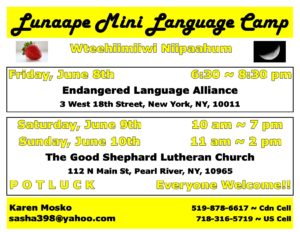 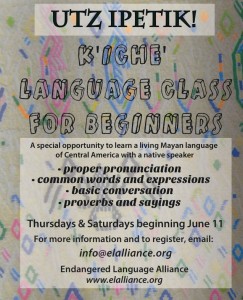 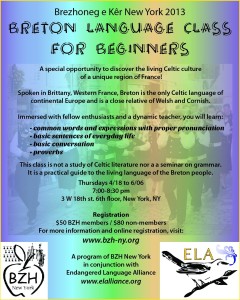 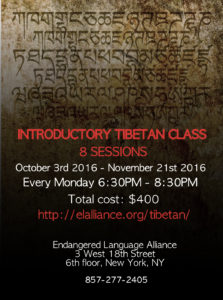 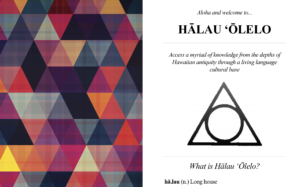 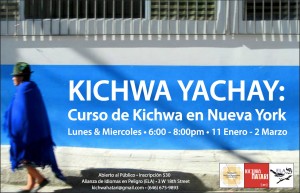 |
Classes organized by ELA have included:
Lunaape (Lenape) 2017-2018
New York City may be the most linguistically diverse place in the world, but that diversity began with Lunaape (also called Lenape or Delaware), a Native American language of the Algonquian family. Today, Lunaape is actively being revitalized in Canada, Oklahoma, and elsewhere.
ELA is honored to host monthly classes, every third Friday of the month, taught by Karen Hunter, who has been teaching and revitalizing her language for over a decade. It may mark the first time in 300 years that the language has been taught in the traditional part of Lunaape-speaking territory that includes NYC.
Tibetan Fall 2016
Yeshi Jigme Gangne, a native speaker who has experience teaching Tibetan in India and the U.S. and is now a Tibetan-language project manager at Google, taught the basics of reading, writing, and speaking Tibetan in a small-group setting. A language with a long literary tradition and several million speakers, Tibetan is now spoken in more parts of the world than ever before, including a growing community in New York City.
Hawaiian Summer-Fall 2016
Kainoa Embernate taught introductory and intermediate Hawaiian classes in the summer of 2016 in collaboration with Ka Leo Nūioka. Hawaiian has become a model of language revitalization in the past few decades; there are now Hawaiian-medium schools from preschool through graduate school. Kainoa went through the Hawaiian system and is now devoted to teaching the language and its culture. The classes are part of an initiative to teach Hawaiian in New York and will continue to be taught at ELA as well as at other locations. zvlasses are centered around the Nā Kai ʻEwalu textbook.
See https://halauolelo.com/ for Kainoa’s ongoing virtual Hawaiian classes.
Quechua
Quechua is a language family native to the Andean region in South America. It is spoken primarily in Peru, Ecuador, Bolivia, and parts of Chile and Argentina. Widespread as the language of the Inca Empire, there are many languages and dialects in the Quechuan language family.
> Quechua (Southern Quechua) 2016-2018
Southern Quechua, which has more than six million speakers, is the most widely spoken Indigenous language in the Americas. Elva Ambía, native Southern Quechua speaker and founder of the New York Quechua Initiative, is a Peruvian Quechua activist and teacher. The classes at ELA in the summer of 2016 are the first NYQI has hosted. They used material from two textbooks; Qheswa Simi (Spanish medium) and Kawsay Vida (English medium). Further NYQI Quechua classes may be held at ELA in near future – stay tuned!
> Kichwa (Ecuadorian Quechua) Winter 2016
Kichwa classes ran for 8 weeks in the winter of 2016. They were held in collaboration with Kichwa Hatari NY and Tinkunakuy: Centro de Pensamiento y Culturas Andinas and taught by Atik Paguay.
K’iche’ 2015
K’iche is one of the largest Mayan languages of Guatemala and the New York K’iche speaking population is vibrant. The community is particularly centered in Bath Beach, Brooklyn. Classes were led by Alcal radio host and K’iche activist Leobardo Ajtzalam.
Breton 2013
Breton is a Celtic language from the Brittany region in France. Brittany is one of the six Celtic Nations, or regions in Western Europe in which Celtic languages and cultures have survived. Breton classes were taught in 2013 through BZH-NY, a New York-based organization devoted to preserving the Breton cultural heritage.
Nahuatl 2012
Nahuatl is a Uto-Aztecan language native to Mexico. There are approximately one and a half million speakers of the language. Nahuatl classes at ELA were taught by Irwin Sánchez, a native speaker and Nahuatl activist who learned the language from his grandfather in Mexico as a child, in collaboration with Mano a Mano in Brooklyn. The classes were featured on a broadcast on National Public Radio (NPR).
This program is supported, in part, by public funds from the New York City Department of Cultural Affairs in Partnership with the City Council.


